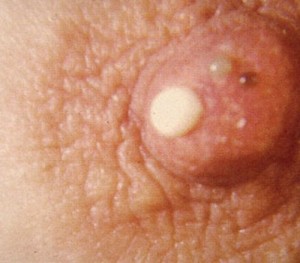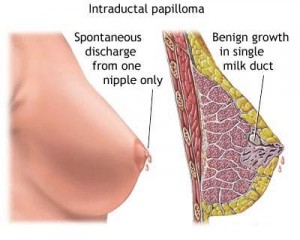Galactorrhea Definition
Page Contents
Galactorrhea is a condition characterized by milky discharge from the nipple that is unrelated to normal milk production associated with childbirth and breastfeeding. Although Galactorrhea itself is not a disease and is frequently benign, it can be an indication of some serious underlying problem. It generally occurs in women, including those who never had children and even in menopausal women. However, it can also affect men as well as adolescents and infants of both sexes. The milky white liquid may get discharged from either or both breasts with or without any stimulation.
The condition is also spelled as Galactorrhoea.
Galactorrhea Epidemiology
The disease is believed to occur in almost 5% to 32% of women. In women, the condition might occur due to physiological factors. In men, it is always pathological. Many women with this disease also suffer from Amenorrhoea.
Galactorrhea Causes
The disorder can be caused by a number of factors, some of which are known whereas others are idiopathic. Tumors of pituitary gland known as prolactinomas or pituitary adenomas can give rise to this condition. Pituitary tumors are generally non-cancerous. A hormone known as Prolactin triggers milk production. Excessive secretion of prolactin or hyperprolactinaemia caused by pituitary tumors can lead to galactorrhea. Overproduction of prolactin may even cause cessation of menstrual periods of a woman and lead to infertility.
Other factors that may give rise to this disorder include:
Hormonal imbalances
The hormonal problems that can give rise to this condition include:
- Hypothyroidism
- Elevated levels of TRH and TSH hormones
Drugs and medications
The various drugs and medications which can cause the disorder include:
- Reserpine
- Verapamil
- Tranquilizers
- Phenothiazines
- Metoclopramide
- Antinausea drugs
- Certain pain killers
- Blood pressure drugs
- Proton-pump inhibitors
- Tricyclic antidepressants
- Serotonin reuptake inhibitors
- Some antigastroesophageal reflux medicines
- Second generation H2 receptor antagonist drug Cimetidine
- Starting or stopping to consume birth control pills and/or other hormones
Herbs
This condition can also be caused by the consumption of certain herbs, such as:
- Anise
- Nettle
- Fennel
- Licorice
- Blessed thistle
- Fenugreek seed
Illicit drugs
Various illicit drugs can cause this disorder. These include:
- Opiates
- Cocaine
- Marijuana
- Risperidone
- Methyldopa
- Antipsychotics
Excessive sexual stimulation of breasts
Excessive sexual arousal of the breasts can also result in the disease.
Diseases
The condition can be caused by certain diseases, such as:
- Lymphoma
- Sarcoidosis
- Esophagitis
- Acromegaly
- Tuberculosis
- Schistosomiasis
- Hypernephroma
- Cushing’s disease
- Multiple sclerosis
- Null-cell adenoma
- Hydatidiform mole
- Craniopharyngioma
- Chronic kidney failure
- Empty-sella syndrome
- Renal adenocarcinoma
- Pituitary-stalk resection
- Bronchogenic carcinoma
- Chronic liver disease or cirrhosis
- Spinal cord injuries, tumors or surgery
- Hypothalamic tumors or diseases like tuberculosis
Chronic emotional stress
Long-term emotional stress may also be responsible for this disorder.
Chest wall conditions
Galactorrhoea can occur due to certain chest wall conditions, like:
- Burns
- Trauma
- Shingles
- Surgical scars
- Herpes zoster
- Atopic dermatitis
- Tumors of the chest wall
Breast conditions
Some specific breast conditions can also lead to the development of this disorder. These include:
- Breast trauma
- Breast surgery
- Mammary duct ectasia
- Intraductal papilloma, a type of benign tumor of breast duct
- Mastitis or a type of breast infection occurring mainly in breastfeeding women
Galactorrhea in men
In men, the occurrence of Galactorrhea might be linked with deficiency of testosterone (male hypogonadism) and is usually accompanied by breast enlargement and/or tenderness (Gynecomastia). Other problems associated with deficiency of testosterone include erectile dysfunction and lack of adequate sexual desire.
Galactorrhea in newborns
Galactorrhea may also occasionally be seen in newborns. High levels of maternal estrogen cross the placenta and enter into the blood of infants. This can lead to the enlargement of the breast tissue of the infant which might be associated with milky nipple discharge. Milk secreted from the breasts of newborn infants is referred to as “Witch’s milk” or “Neonatal milk”.
Galactorrhea Symptoms
The primary symptom of this disorder is discharge of a milky white liquid from the nipple that is not associated with breastfeeding. This discharge can emanate from one or both the breasts. Other signs and symptoms that might occur alongside this discharge include:
- Headaches
- Visual difficulties
- Impotence (men only)
- Loss of sex drive
- Intolerance of heat or cold
- Increased thirst and/or urination
- Acne or abnormal growth of hair
- Bloody or bad-smelling discharge
- Nipple discharge that involve multiple milk ducts
- Abnormal menstruation or absence of menstruation
- Non-milky nipple discharge, which may be bloody, yellow or clear
- Disordered or irregular appetite and a decrease or increase in weight
Galactorrhea Diagnosis
Finding out the underlying causes of this disorder might be a difficult task as a number of factors can lead to it. A doctor is likely to first inquire about the symptoms of patients and their overall medical history. He or she will then recommend certain physical examinations, which may include the following:
- Inspection of the nipples and the area surrounding them; checking for breast lumps as well as other suspicious areas having thickened breast tissues
- Analysis of the fluid discharged from the nipples, to check the presence of fat droplets in the fluid
- Blood tests, for checking the levels of hormones such as prolactin and thyroid-stimulating hormone
- A pregnancy test, to confirm or exclude pregnancy as possible factor causing nipple discharge
- Mammography, to produce images of the breast tissues and check whether there are any lumps or suspicious breast tissues
- Ultrasounds, for the same purpose as mentioned above
- MRI (magnetic resonance imaging) scans, to check for tumors or other abnormalities of the pituitary gland, if blood tests reveal elevated levels of prolactin
- CT scans
If a doctor suspects the symptoms of Galactorrhea to be caused by some form of medication, he or she might instruct sufferers to stop taking that particular drug for a short span of time for assessing the possible cause.
Galactorrhea Differential Diagnosis
The differential diagnoses of the condition include ensuring the absence of diseases that can produce similar symptoms. These include:
- Neurological disorders
- Pituitary adenomas
- Hypothyroidism
- Breast stimulation
- Chest wall irritation
- Numerous medications
- Other physiological causes
The following conditions are often considered during the DDx of Galactorrhea:
- Drug reactions
- Duct papilloma
- Pituitary tumors
- Testicular tumors
- Ovarian neoplasm
- Craniopharyngioma
- Cushing’s Syndrome
- Renal cell carcinoma
- Mammary duct ectasia
- Chiari-Frommel syndrome
- Complications from surgeries
- Prolactin producing tumor (ectopic)
- Pituitary microadenoma and prolactinoma
Galactorrhea Treatment
The treatment for this condition depends on the underlying causes. Medical treatment is not required in some mild instances; the symptoms dissolve automatically on their own. In such cases, breast binders may be used to protect the nipples from overstimulation. If the milky discharge is caused by some medications, they should be replaced by safer alternatives.
If an underactive thyroid gland is responsible for this condition, it should be treated with medications such as Levothyroxine. This can help to counter insufficient production of hormones by the thyroid gland.
If Galactorrhea is caused by a benign pituitary tumor, it can be removed by medications or surgery. Small tumors can be treated by medications such as bromocriptine. The larger tumors can be treated by the following methods:
Surgery
The tumor and the nearby tissues can be removed surgically. This option is especially considered when medicines fail to generate expected results.
Radiotherapy or Radiation therapy
Radiation can be used to shrink the tumors when drugs and surgery do not produce effective results.
Galactorrhea Complications
Certain medications used for curing this disease may produce side effects, such as:
- Headaches
- Dizziness
- Nausea
Untreated hyperprolactinaemia may also increase the risk of development of Osteoporosis.
Galactorrhea Prognosis
The outcome of treatment for patients having prolactinomas is generally good. Most prolactinomas either regress or remain stable. In pregnant women, these tumors should be observed closely as they may increase significantly in size. The tumors may also recur after treatment.
Galactorrhea Prevention
The following precautionary measures should be followed to minimize the risks of development of Galactorrhea:
- Avoid wearing clothing or apparel that irritates the breasts.
- Avoid frequent self-examination of the breasts; usually once per month is sufficient.
- Avoid too much sexual stimulation of breasts.
- Avoid the usage of illicit drugs.
Galactorrhea Pictures
The following images give a clearer idea regarding the nature of this disease.
Picture 1 – Galactorrhea
Picture 2 – Galactorrhea Image
References:
http://www.mayoclinic.com/health/galactorrhea/DS00761
http://www.thirdage.com/hc/c/galactorrhea
http://medicine.med.nyu.edu/endocrinology/conditions-we-treat/conditions/galactorrhea
http://en.wikipedia.org/wiki/Galactorrhea
http://pms.about.com/od/pelvichealthdiseases/f/8057_glactorrhe.htm


